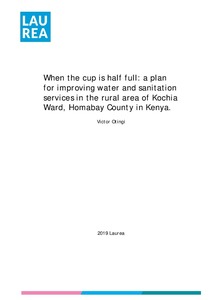When the cup is half full: a plan for Improving Water and Sanitation Services in the Rural area of Kochia Ward, Homabay County in Kenya
Otingi, Victor Omondi (2019)
Otingi, Victor Omondi
2019
All rights reserved. This publication is copyrighted. You may download, display and print it for Your own personal use. Commercial use is prohibited.
Julkaisun pysyvä osoite on
https://urn.fi/URN:NBN:fi:amk-2019060515044
https://urn.fi/URN:NBN:fi:amk-2019060515044
Tiivistelmä
Access to safe drinking water and sanitation is considered a fundamental human right that acts as a safeguard to health and dignity. When sanitation systems fail, or are inadequate, the impacts on the health of the community, the health of others, and the environment can be extremely serious. Good sanitation and hygiene practices can make major differences in people´ health, education and socioeconomic development. The economic benefits of improved sanitation include savings in health costs, higher worker productivity, better school attendance and quality of education, and reduced water treatment costs.
The project plan aims to assess the water supply and sanitation situation in the rural village of Kochia in Homabay county, Kenya, to identify water supply and sanitation related problems and challenges, including water contamination and pollution, to identify possible mitigation measures the residents proposed towards the water and sanitation related problems and finally to create a criteria for monitoring and evaluation for the performance of the project.
Participant observation was used as a method for this study. Observation done during the sanitation walk gave the exact extent and condition of how the situation looks like in the study area. It presented an opportunity to correctly mark what the villagers had to say pertaining the water and sanitation status, marking the checklist against the actual on the ground. Economic status was also analyzed during the sanitation walk, the distribution pattern, and the overall viability of the project. Participant observation is accepted almost universally as the central and defining method of research in cultural anthropology.
Water supply in the village is very poor as the residents rely on bucket as away of fetching water from the main water source. Only few households have installed huge capacity tanks to help in preserving rain waters. Sanitation system is very poor in the village. The few available latrines are not properly maintained as open defecation is still practiced by some residents.
Water and sanitation is still an important global goal and should be equally provided for to the rural areas just as the concentration has been much in urban centers. It will provide the basic essential health for a sustainable life and economic development, hence improving the overall livelihood.
The project plan aims to assess the water supply and sanitation situation in the rural village of Kochia in Homabay county, Kenya, to identify water supply and sanitation related problems and challenges, including water contamination and pollution, to identify possible mitigation measures the residents proposed towards the water and sanitation related problems and finally to create a criteria for monitoring and evaluation for the performance of the project.
Participant observation was used as a method for this study. Observation done during the sanitation walk gave the exact extent and condition of how the situation looks like in the study area. It presented an opportunity to correctly mark what the villagers had to say pertaining the water and sanitation status, marking the checklist against the actual on the ground. Economic status was also analyzed during the sanitation walk, the distribution pattern, and the overall viability of the project. Participant observation is accepted almost universally as the central and defining method of research in cultural anthropology.
Water supply in the village is very poor as the residents rely on bucket as away of fetching water from the main water source. Only few households have installed huge capacity tanks to help in preserving rain waters. Sanitation system is very poor in the village. The few available latrines are not properly maintained as open defecation is still practiced by some residents.
Water and sanitation is still an important global goal and should be equally provided for to the rural areas just as the concentration has been much in urban centers. It will provide the basic essential health for a sustainable life and economic development, hence improving the overall livelihood.
